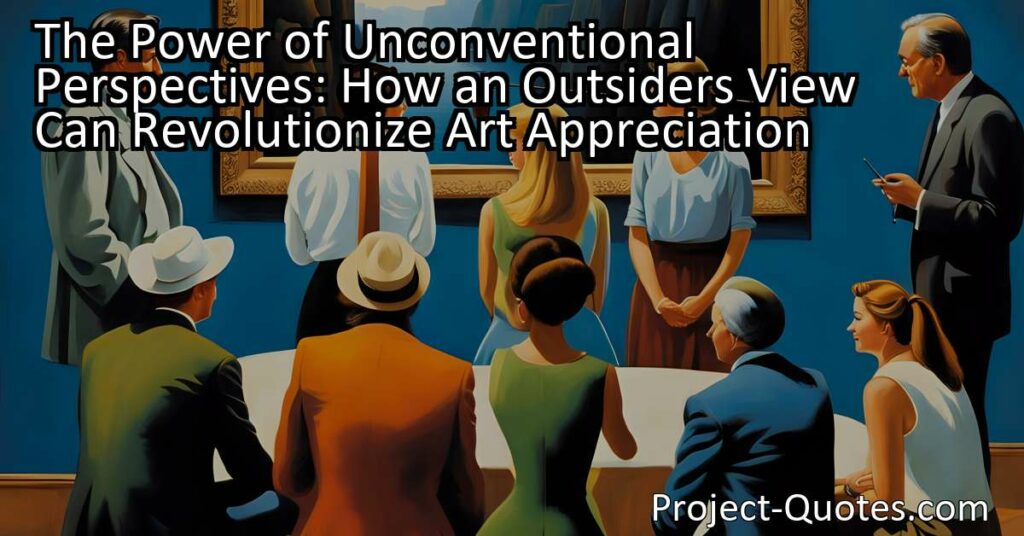I have generally found that persons who had studied painting least were the best judges of it.
William Hogarth
Renowned artist William Hogarth challenges the belief that expertise is necessary for understanding and appreciating art. By approaching paintings with curiosity, open-mindedness, and personal experiences, individuals without formal art training provide fresh and genuine interpretations that go beyond technical intricacies. Their unburdened viewpoints and emotional reactions offer valuable insight and expand the boundaries of artistic appreciation.
Table of Contents
Meaning of Quote – I have generally found that persons who had studied painting least were the best judges of it.
Have you ever walked into an art gallery and felt overwhelmed by the sheer beauty and complexity of the paintings on display? Have you ever wondered how some people can effortlessly appreciate and understand the intricacies of art, while others struggle to make sense of it all? Well, according to the renowned artist William Hogarth, the answer may lie in the surprising observation that those who have studied painting the least are often the best judges of it.
Hogarth’s statement challenges the commonly held belief that expertise is a prerequisite for true understanding and appreciation of any given subject. In the world of art, where technical skills and artistic knowledge are highly valued, it is fascinating to consider the possibility that an outsider’s perspective might bring a fresh and unbiased viewpoint to the table.
To fully grasp the essence of Hogarth’s assertion, it is important to delve into the reasoning behind it. When someone studies painting extensively, they become entrenched in the intricacies and conventions of the art form. They learn about color theory, composition, and brush techniques, and they develop a keen eye for detail. This deep knowledge can sometimes hinder their ability to see beyond the technical aspects of a painting, and instead, they may focus solely on the mastery of skill rather than the emotional impact or conceptual meaning of the artwork.
On the other hand, individuals who have not had formal training in art might approach a painting with unadulterated curiosity and open-mindedness. They have not been inundated with the theories and rules of the art world, allowing them to engage with the artwork on a more instinctive and raw level. Their reactions are fueled by innate emotions, personal experiences, and their unique perspectives. By not being bound by the restrictions of academia, they are free to interpret the artwork based solely on their own understanding and feelings, bringing a refreshing and genuine authenticity to their judgment.
One might wonder how this phenomenon comes to be. Well, it can be argued that being unburdened by preconceived notions about art grants these individuals the freedom to form their opinions in an unbiased manner. They are not influenced by the expectations and standards set by the art world or the judgments of others. Instead, their judgment is guided by their intuition and emotional response, resulting in a genuine and unfiltered interpretation of the artwork.
Moreover, when one lacks the technical knowledge of painting, they may rely more on the visual impact of a painting rather than on its technical execution. They may be captivated by the use of color, the balance of composition, or the evocative power of the subject matter. These elements, which can sometimes be overshadowed by technical intricacies for those with an extensive art education, become the driving force behind their judgment.
Another aspect to consider is the idea of relatability. Those who are less versed in painting may find it easier to connect with a painting that speaks to them on a personal level. Whether it reminds them of a cherished memory, reflects their own emotions, or sheds light on a topic they are passionate about, a painting’s ability to resonate with an individual is a powerful indicator of its impact. By approaching art from a more personal and subjective standpoint, individuals without extensive artistic training are able to tap into this relatability and truly engage with the artwork in a profound way.
It is important to note that Hogarth’s statement does not diminish the value of artistic education or technical skill in any way. The study of painting is crucial for artists to hone their craft, develop their own artistic voice, and fully understand the historical and cultural context of the art form. The artistic expertise gained through years of study and practice should never be disregarded.
However, what Hogarth’s statement emphasizes is the importance of balancing technical knowledge with a fresh perspective. In an ever-evolving art world, where new forms of expression and unconventional techniques constantly emerge, the viewpoints of individuals who have not been conditioned by traditional academic norms can provide valuable insight and expand the boundaries of artistic appreciation.
To illustrate this point, let us imagine a scenario where a renowned art critic, who has dedicated their life to studying art, and an individual with minimal knowledge of painting both encounter a provocative and abstract artwork. The critic may spend hours dissecting the technical elements of the painting, analyzing brush strokes, and comparing it to other works in art history. Meanwhile, the person with little artistic education might be captivated by the emotional intensity of the piece, the sense of mystery it evokes, and the personal reaction it elicits. Both perspectives are valid and contribute to the overall understanding and appreciation of the artwork.
In the end, the best judges of art can be found in a diverse spectrum of individuals. It is not solely about expertise or lack thereof, but rather about a genuine and open-minded approach to art. Whether one is a trained artist, an avid art lover, or simply a curious observer, the ability to truly connect with a painting and derive meaning from it is what makes us all capable of being great judges of art.
So, the next time you find yourself standing in front of a magnificent painting, let go of any reservations or insecurities you may have about your artistic knowledge. Instead, embrace your unique viewpoint and trust your instinctive response. Remember, it is the unfiltered and unbiased perspective that often has the power to shed new light on the wondrous world of art.
I hope this quote inspired image brings you hope and peace. Share it with someone who needs it today!


